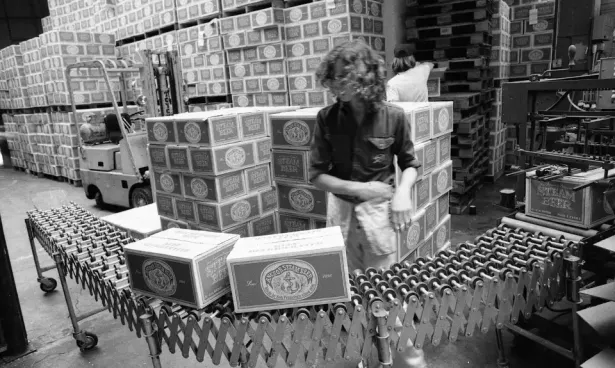Well, we didn’t see that one coming.
Of all the players who might have bought the shuttered Anchor Brewing — the scrappy ex-employees, the venture capitalist neighbor, the Big Beer corporations that we all assumed were interested — Hamdi Ulukaya, the billionaire founder of Chobani yogurt, was never a top suspect.
San Franciscans would be right to be skeptical of Ulukaya, who has no apparent connection to our city or to craft beer. Especially since he told the Chronicle he “didn’t know Anchor existed” until last summer. Sure, he plans to revive the old logos, rehire as many employees as possible and begin brewing steam beer again. Still, it’s reasonable to wonder whether he may value his new asset primarily as a real estate investment. Could stewarding the legacy of America’s first craft brewery, which San Franciscans know to be a sacred honor, end up being an afterthought?
But as far as billionaires go, Ulukaya sounds like one you might actually be able to cheer for. He has an irresistible origin story, after growing up in a family of sheep herders in the Turkish mountains, he immigrated to the United States with only $3,000 to his name and launched Chobani after buying a dilapidated Kraft yogurt factory. By giving his workers a 10% stake in Chobani, employing large numbers of refugees and donating lavishly to charitable causes, Ulukaya has endeared himself to the socially conscious business world. He has amassed the accolades to prove it: honorary doctorates galore, humanitarian awards, an appointment by President Obama to a global entrepreneurship group.
But that still doesn’t answer the question on San Franciscans’ minds. Does Ulukaya know what this brewery means to us? Does he get Anchor?
Anchor Brewing is more than just a beloved institution in this city. It’s the very myth of San Francisco in a bottle. It’s a relic of the Gold Rush, a harbinger of the it-happened-here-first innovation that our region hopes to be known for. Anchor was a survivor, for 127 years, of San Francisco’s periods of buoyant boom and brutal bust. Its signature beer, Steam, can even be seen as an expression of the city’s uniquely quirky climate: Long before temperature control was available, Steam’s fermentation was regulated only by the cool bay breeze.
In the second half of the 20th century, as Big Beer consolidated and an American craft movement rose to meet it, Anchor seemed to represent San Francisco’s stubbornly independent streak. Fritz Maytag, who owned the brewery from 1965 until 2010, presided over its golden era. With longtime brewer Mark Carpenter, he restored Anchor Steam’s quality, making it one of the great American beers. They introduced the first IPA in this country since Prohibition, Liberty Ale, reviving the lost practice of dry hopping and setting off a trend that would captivate a generation of brewers.
While the corporations now known as AB InBev and Molson Coors got bigger and bigger, buying up smaller breweries, Anchor felt like proof that it was possible to remain homegrown. That is, until 2010, when Maytag sold Anchor to two former Skyy Spirits executives, who then turned around and sold it to Sapporo in 2017.
But even before Maytag shattered the illusion of independence, the Anchor myth was never as pure as San Francisco would like to have believed. Its founding, in fact, was arguably a buyout: In 1896, Ernst F. Baruth and his son-in-law Otto Schinkel Jr. bought a 25-year-old brewery on Pacific Street and rebranded it as Anchor. For the next 69 years, it kept getting traded among new owners, some of whom barely managed to keep it alive. One of those owners didn’t: Anchor closed in 1959, though it was resuscitated a year later and limped along until Maytag’s purchase.
Like Ulukaya, Maytag was merely the latest in a series of owners to try their luck with this beleaguered little brewery. Like Ulukaya, Maytag was not a Bay Area native — he grew up in Iowa and moved here to attend Stanford. Like Ulukaya, Maytag came to Anchor flush with a fortune from an existing business empire — in his case, his family’s washing machine company.
So even though another owner, like the neighbors or the employees, might have made for a better story in this next chapter of Anchor’s life, there’s reason to be optimistic about Ulukaya. Keep in mind that this could certainly have gone a lot worse. Anchor’s assets could easily have been divided among multiple buyers, divorcing the brand and beer recipes from the physical brewery and its specialized, antique equipment. It was not a guarantee that a new owner would continue brewing Anchor beer in San Francisco, or even continue brewing Anchor beer at all — two things Ulukaya said he’s committed to doing.
Then again, we’ve been burned before. In 2017, we tried to convince ourselves that Sapporo was OK. At least it wasn’t AB InBev. And it turned out to be a disaster: Sapporo muddled Anchor’s identity, introducing wacky beers like blackberry IPA that would likely have made Maytag shudder and rolling out controversial new labels. Then, after all that, the Japanese company deflated Anchor in a series of disheartening downsizings. First Sapporo cut national distribution and its beloved Christmas Ale. Then it just shut down Anchoraltogether.
The crucial difference between 2017 and 2024 is the health of the overall craft beer market. When Sapporo came in, the craft beer explosion was at its peak. But the wave has since crested. Today, craft beer is stagnating, declining in volume by 1% last year, according to the Brewers Association, after several years of flat growth. Anchor’s shuttering last year was one of various brewery closuresthat the Bay Area has seen recently.
But that’s the power of the myth of Anchor, much like the myth of San Francisco itself. Even when it looks like folly, a starry-eyed prospector can’t resist the chance to come here and try to strike gold.
Reach Esther Mobley: emobley@sfchronicle.com


Spread the word